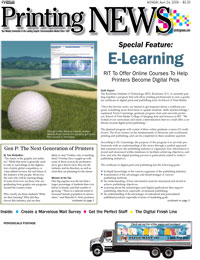|
  Apr. 24, 2006—"The future of the graphic arts industry." While that term is generally used to refer to such things as the digitization of print, global competition, or value-added services, the real future of the industry is the people. Moreover, the ones who will be running things 10 years from now are those who are graduating from graphic arts programs around the country today. Apr. 24, 2006—"The future of the graphic arts industry." While that term is generally used to refer to such things as the digitization of print, global competition, or value-added services, the real future of the industry is the people. Moreover, the ones who will be running things 10 years from now are those who are graduating from graphic arts programs around the country today.
Who exactly are these students? What are they learning? Why did they choose this industry, and are they likely to stay? Further, who is teaching them? Printing News caught up with some of these soon-to-be professionals to get a feel for how they see the industry and its direction, as well as what they are planning for the future.
Women at the Top
One big surprise was the fact that a larger percentage of students than ever before is female, and that number is growing. "There is a national trend of increased female population in universities," said Malcolm G. Keif, professor, California Polytechnic State University (Cal Poly) in San Luis Obispo, Calif. "Approximately 70 percent of our students are female."
Patricia Sorce, professor, department chair, SPM, Rochester Institute of Technology (RIT), Rochester, N.Y., concurred, noting that, "We have a lot more female students than we did only a few years ago."
For the industry, that means that the face of print will become decidedly more feminine in the next few decades. The overall perception that graphic arts is a manufacturing industry dominated by men is fast becoming ancient history.
The students themselves have a wide range of ambitions, from graphic designers, to customer service representatives (CSRs), to press operators, to print salespeople, and even print buyers. The overwhelming thing that ties them together is a passion for print, and an excitement for all the potential the industry has to offer.
"The overall craftsmanship appeals to me," said Casey Crocker, a student at Central Missouri State University (CMSU), Warrensburg, Mo. "The internal gratitude that you printed something that benefits the whole world, all the way down to a single person...there is so much out there. You can't turn around and not see something printed."
The love of print, and following a piece from conception to final product was echoed by students across the country. The industry appeals to a wide range of personalities, but all have an intense interest in how technology and creativity are no longer mutually exclusive.
"I chose the graphic arts industry for its constant ability to adapt and adjust according to technological advancement," noted David Cook, CMSU. "That, and the creative process associated with design and print is something I have always found interesting."
The interest isn't fading either. Most schools noted that around 90 percent of graduates enter the graphic arts industry right out of school, and an average of 50 percent are still in the industry after 10 years.
"We track our graduates with a survey every three years to see if we are teaching the right things and to find out what they are doing at that point. About 90 percent of our graduates enter the industry. We have found in a follow-up survey that we have about 85 percent of our graduates continuing on in the industry as time goes on," noted John Leininger, professor, Clemson University, Clemson, S.C.
Education to Grow on
Classes across the various schools tend to cover the same basic skills, from estimating to running a press. However, a universal complaint from students was the lack of business courses being offered in the field.
A number of students noted that having a handle on business practices and finances would have helped them feel more prepared to move into management positions as they start their careers. In addition, quite a few noted that knowing how a piece fits into the business puzzle would help them produce better work, make more sales, and relate better to customers.
Another area identified by students as lacking in education was how to deal with customers, not just technology. "I believe we should have a customer service representative (CSR) class to teach the ideas of how to handle customers, as well as sell a product," noted Mr. Crocker.
Mr. Keif agreed, "I wish we had a slightly greater research focus. I also think we could use a bit more management/business focus, perhaps deemphasizing technology slightly."
Looking to the Future
The future of the industry is bright, if these students are anything to go by. They see the problems the industry faces, but they have not lost their enthusiasm or perspective.
"I would go back to when quality was more important than turnaround time," said Mr. Cook. "Quality has certainly taken a back seat to quick turnaround, and I think as a result the quality of print in general has declined on a global scale."
"I wish this industry was more person-oriented, rather than being extremely equipment and technology-oriented," said Katherine Frise, Cal Poly. "I know that technology plays an important role, but so, too, do the people."
These students have a vision for graphic arts, which includes not just changing technologies or any of the catch phrases currently popular. Instead, many of the next generation see a need to return to the roots of what makes this a service sector, instead of a manufacturing one. They recognize that our industry is not about a finished product anymore, it is about creating relationships.
"If I could change anything about the industry," noted Randi Kampeter, CMSU, "it would have to be educating customers about what is really taking place during production. I think they would respect the work much more if they knew everything that had to take place in order for a job to be produced."
These are the people who will be entering this industry as full-time workers over the next two years. They readily admit that they do
not know everything, but they
are excited and ready to take up
the challenge.
"I've learned a lot in school," said Kelly Humphries, CMSU. "What
I've learned is the basics, an overview of how everything works and where it came from—a foundation that will help me fill in the gaps as I go along."
|


